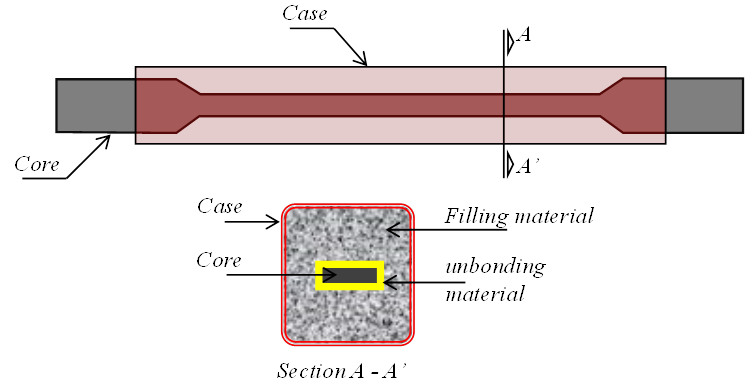EXPERIMENTAL BEHAVIOUR OF A LOW-COST SEISMIC ENERGY DISSIPATION DEVICE
DOI:
https://doi.org/10.18867/ris.102.507Keywords:
dissipationAbstract
Safety during earthquakes should be a human right and shall be accessible not only to those who can pay for proprietary high-tech devices but to everyone. Based on that, this study has been developed with the intention of helping to improve the seismic safety in the developing world. Within this paper, a low-cost, low-tech seismic energy dissipation device is proposed. Its experimental behavior under seismic loading is assessed. The device type is buckling-restrained brace (BRB) and, according to its characteristics, it is suitable for new and existing, medium- to low-rise structures. First, the device characteristics and fabrication process are presented. Then, its structural response, in terms of the hysteretic behavior, ductility, and dissipated energy – as obtained from experimental tests – is shown. Experimental results show an excellent behavior of the proposed device. As a result, it can be said that the device is reliable and its use is recommended for new, and retrofitting/upgrading existing, structures. Design recommendations are also provided.
Downloads
References
Black CJ, Makris N, Aiken ID (2004). Component testing, seismic evaluation and characterization of buckling-restrained braces. J Struct Eng-ASCE. 130:880–94. DOI: 10.1061/(ASCE)0733-9445(2004)130:6(880)
Buendia LM and Reinoso E (2019). Analysis of damages on housing and retail buildings during the ocurrence of the September 19, 2017 Earthquake (in Spanish). Revista de Ingeniería Sísmica No. 101, 19-35. DOI: 10.18867/ris.101.508
Della Corte G, D’Aniello M, Landolfo R (2015). Field Testing of All-Steel Buckling-Restrained Braces Applied to a Damaged Reinforced Concrete Building. Journal of Structural Engineering. 141:D4014004. DOI: 10.1061/(ASCE)ST.1943-541X.0001080
Di Sarno L, Manfredi G (2012). Experimental tests on full-scale RC unretrofitted frame and retrofitted with buckling-restrained braces. Earthquake Engineering & Structural Dynamics. 41(2):315-33. DOI: 10.1002/eqe.1131
Fahnestock L, Ricles J, Sause R (2007). Experimental Evaluation of a Large-Scale Buckling-Restrained Braced Frame. Journal of Structural Engineering. 133:1205-14. DOI: 10.1061/(ASCE)0733-9445(2007)133:9(1205)
Galvis F, Miranda E, Heresi P, Dávalos H, Silos JR (2017). Preliminary Statistics of Collapsed Buildings in Mexico City in the September 19, 2017 Puebla-Morelos Earthquake. John A. Blume Earthquake Engineering Center, Stanford University.
García E (2020). Experimental Charaterization of low-cost seismic dissipation devices (in Spanish). M. Eng. Thesis. Institute of Engineering, UNAM, Mexico.
Guerrero H (2016). Seismic Design and Performance of Hospital Structures Equipped with Buckling-Restrained Braces in the Lakebed Zone of Mexico City. PhD Thesis, The University of Manchester, UK.
Guerrero H, Ji T, and Escobar JA (2016a). Experimental studies of a steel frame model with and without Buckling-Restrained Braces. Revista de Ingeniería Sísmica No. 95 33-52. DOI: 10.18867/RIS.95.338
Guerrero H, Ji T, Teran-Gilmore A, Escobar JA (2016b). A Method for Preliminary Seismic Design and Assessment of Low-Rise Structures Protected with Buckling-Restrained Braces. Engineering Structures. 123:141-54. DOI: 10.1016/j.engstruct.2016.05.015
Guerrero H, Ruíz-García J, Escobar JA, Terán-Gilmore A (2017a). Response to seismic sequences of short-period structures equipped with Buckling-Restrained Braces located on the lakebed zone of Mexico City. Journal of Constructional Steel Research.137:37-51.
DOI: 10.1016/j.jcsr.2017.06.010
Guerrero H, Terán-Gilmore A, Ji T, Escobar JA (2017b). Evaluation of the economic benefits of using Buckling-Restrained Braces in hospital structures located in very soft soils. Engineering Structures. 136:406-19. DOI: 10.1016/j.engstruct.2017.01.038
Guerrero H, Ji T, Escobar JA, Teran-Gilmore A (2018a). Effects of Buckling-Restrained Braces on reinforced concrete precast models subjected to shaking table excitation. Engineering Structures. 163:294-310. DOI: 10.1016/j.engstruct.2018.02.055
Guerrero H, Escobar JA, Teran-Gilmore A (2018b). Experimental damping on frame structures equipped with buckling-restrained braces (BRBs) working within their linear-elastic response. Soil Dynamics and Earthquake Engineering. 106:196-203. DOI: 10.1016/j.soildyn.2017.12.028
Kersting RA, Fahnestock LA, López WA (2015). Seismic Design of Steel Buckling-Restrained Braced Frames. NIST GCR 15-917-34.
Mazzolani FM, Corte GD, D'Aniello M (2009). Experimental analysis of steel dissipative bracing systems for seismic upgrading. Journal of Civil Engineering and Management. 15:7-19. DOI: 10.3846/1392-3730.2009.15.7-19
Merrit S, Uang C-M, Benzoni G (2003). Subassemblage testing of Corebrace Buckling-Restrained Braces. La Jolla, California: University of California, San Diego.
MCBC (2017). Mexico City Building Code and its Complementary Design Norms. Mexico City, Mexico.
Opensees (2014). Open Source finite element platform for earthquake engineering simulations. Univ. of California, Berkeley: Pacific Earthquake Engineering Center.
Palazzo G, López-Almansa F, Cahís X, Crisafulli F (2009). A low-tech dissipative buckling restrained brace. Design, analysis, production and testing. Engineering Structures. 31:2152-61. DOI: 10.1016/j.engstruct.2009.03.015
Pujol S y Rodriguez ME (2019). Performance evaluation of nonstructural walls in buildings in Mexico City during the September 19, 2017 Earthquake (in Spanish). Revista de Ingeniería Sísmica No. 101, 53-66. DOI: 10.18867/ris.101.529
Rodriguez ME (2019). Interpretation of observed damages and collapses in buildings in Mexico City during the September 19, 2017 Earthquake (in Spanish). Revista de Ingeniería Sísmica No. 101, 1-18. DOI: 10.18867/ris.101.528
Sánchez Arriaga D (2020). Hybrid Simulation of a structure equipped with Buckling-Restrained Braces (in Spanish). M. Eng. Thesis. Institute of Engineering, UNAM, Mexico.
Singh SK, Suárez G (1986). Review of the Seismicity of Mexico with Emphasis on the September 1985, Michoacan Earthquakes. Intenational Conference on the Mexico Earthquakes of 1985. Mexico City, Mexico.
Tremblay R, Bolduc P, Neville R, DeVall R (2006). Seismic testing and performance of buckling-restrained bracing systems. Canadian Journal of Civil Engineering. 33:183-98. DOI: 10.1139/l05-103
Uang C-M, Nakashima M (2004). Steel Buckling-Restrained Braced Frames. In: Bozorgnia Y, Bertero VV, editors. Earthquake Engineering from Engineering Seismology to Performance-Based Engineering. CRC Press.






